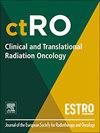Ultrahypofractionated radiotherapy for localised prostate cancer: The impact of daily MRI-guided adaptive radiotherapy on delivered dose
IF 2.7
3区 医学
Q3 ONCOLOGY
引用次数: 0
Abstract
Introduction
Magnetic resonance image-guided adaptive radiotherapy (MRIgART) reduces uncertainties by correcting for day-to-day target and organ-at-risk deformation and motion. This is the first study to examine the dosimetric impact of MRIgART for ultrahypofractionated prostate cancer treatment, compared to standard-of-care image-guided non-adapted radiotherapy.
Methods
Twenty patients with localised prostate cancer, who received ultrahypofractionated MRIgART on the Unity MR linac (Elekta, Sweden) were retrospectively analysed. Online daily MRI was acquired for replanning (MRIsession) and a second for position verification before treatment (MRIverification). To compare delivered dose with and without adaptation, three plans were generated offline per fraction; a session plan (reference plan adapted to MRIsession anatomy), a verification plan (session plan recalculated on MRIverfication anatomy), and a non-adapted plan (reference plan recalculated on MRIverfication anatomy). Target and organ-at-risk doses were calculated, and dose difference evaluated.
Secondary analysis, using deformable dose accumulation, estimated verification and non-adapted dose to primary target (CTVpsv) substructures; prostate, gross tumour volume (GTV) and proximal 1 cm of seminal vesicles (1cmSV). Impact of prostate, rectum and bladder volume changes on dose were evaluated.
Results
Median dose to 95 % of the CTVpsv was significantly higher with adaptation; 40.3, 40.0 and 38.2 Gy for session, verification, and non-adapted plans. Adaptation achieved a lower median urethra V42Gy dose but bladder V37Gy dose was lower when not adapting. Rectum V36Gy dose was similar for adapted and non-adapted plans.
CTVpsv substructure dose difference was greatest for 1cmSV; 40.0 versus 37.5 Gy for verification/non-adapted plans. Adaptation achieved significantly higher prostate only, but not GTV doses. Prostate and rectal volume changes had a negative impact on non-adapted dose only.
Conclusion
MRIgART, offers significant dosimetric benefit for ultrahypofractionated prostate cancer compared to non-adapted strategies. Greatest benefit is expected for those with SV or high-risk of SV involvement, persistent rectal gas, prostate swelling and for the application of novel dose strategies including GTV dose escalation and non-involved prostate dose de-escalation.
局部前列腺癌的超分割放疗:每日mri引导下的适应性放疗对输送剂量的影响
磁共振图像引导自适应放疗(MRIgART)通过纠正日常目标和器官的危险变形和运动来减少不确定性。这是第一个研究MRIgART对超低分割前列腺癌治疗的剂量学影响的研究,与标准护理图像引导的非适应放疗相比。方法回顾性分析20例局部前列腺癌患者在Unity磁共振直线仪(Elekta,瑞典)上接受超低分割mri igart治疗。每日在线MRI用于重新规划(MRIsession),第二次用于治疗前的位置验证(MRI验证)。为了比较有和没有适应的递送剂量,每个分数离线生成三个计划;会话计划(参考计划适应于mrsession剖析)、验证计划(会话计划在MRIverfication剖析中重新计算)和非适应计划(参考计划在MRIverfication剖析中重新计算)。计算靶剂量和器官危险剂量,并评估剂量差异。二次分析,使用可变形剂量累积、估计验证和主要目标亚结构的非适应剂量(CTVpsv);前列腺,总肿瘤体积(GTV)和近1cm精囊(1cmSV)。评估前列腺、直肠和膀胱体积变化对剂量的影响。结果适应组CTVpsv的中位剂量至95%显著升高;40.3、40.0和38.2 Gy用于会话、验证和非改编计划。适应时尿道中位剂量V42Gy较低,不适应时膀胱中位剂量V37Gy较低。直肠V36Gy剂量调整方案与非调整方案相似。CTVpsv亚结构剂量差异在1cmSV时最大;40.0 Gy对验证/非改编计划的37.5 Gy。适应只显著提高了前列腺剂量,而不是GTV剂量。前列腺和直肠体积变化仅对非适应剂量有负面影响。结论与非适应策略相比,mrigart对超低分形前列腺癌具有显著的剂量学优势。对于SV或SV受损伤高危患者、持续性直肠气体、前列腺肿胀以及包括GTV剂量递增和非受损伤前列腺剂量递减在内的新型剂量策略的应用,预期获益最大。
本文章由计算机程序翻译,如有差异,请以英文原文为准。
求助全文
约1分钟内获得全文
求助全文
来源期刊

Clinical and Translational Radiation Oncology
Medicine-Radiology, Nuclear Medicine and Imaging
CiteScore
5.30
自引率
3.20%
发文量
114
审稿时长
40 days
 求助内容:
求助内容: 应助结果提醒方式:
应助结果提醒方式:


